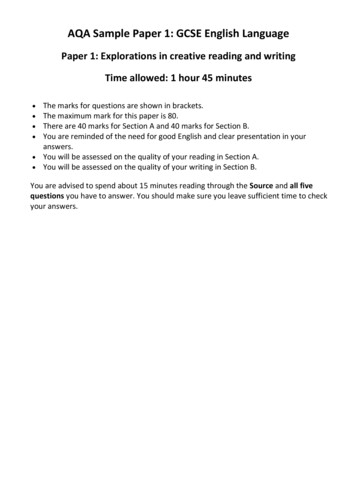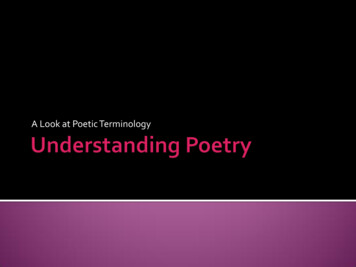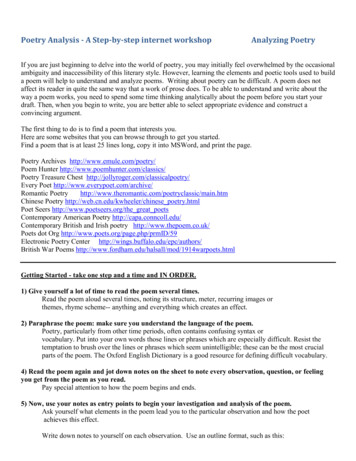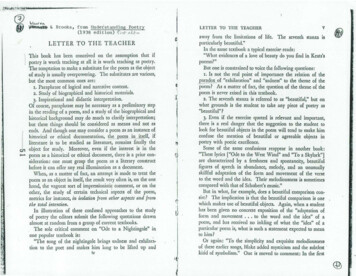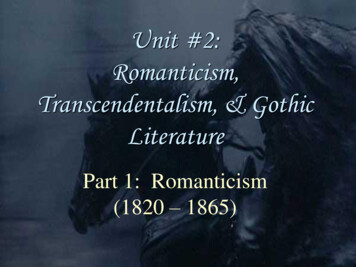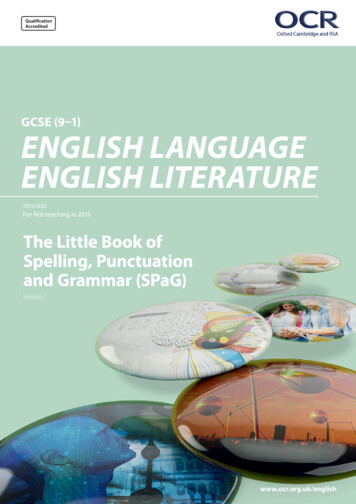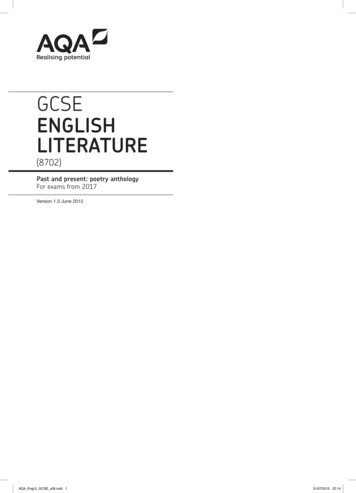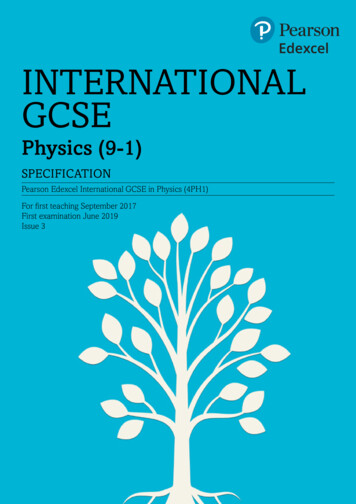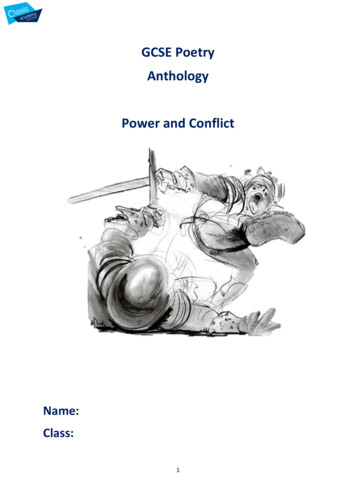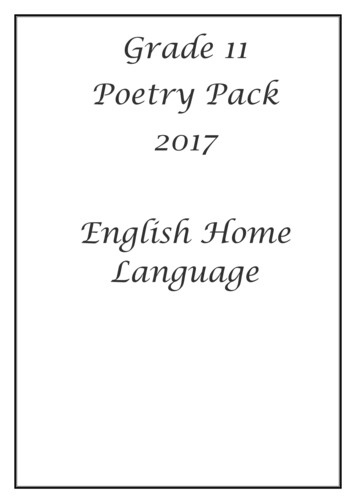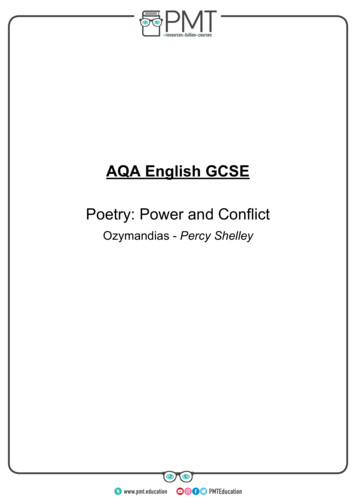
Transcription
AQA English GCSEPoetry: Power and ConflictOzymandias - Percy Shelleywww.pmt.education
OZYMANDIASPercy ShelleyBrief SummaryThe poem concerns the discovery of a semi-destroyed anddecaying statue of Ramesses II, also known as Ozymandias,and shows how power deteriorates and will not last forever.Synopsis Report from a stranger of a statue in a desertStatue is falling apart and decayingThe sculptor has made it in a way that portrays the crueltyof the kingKing’s pedestal claims he was "king of kings" – showshis arroganceIrony of his claims when the statue is surrounded byendless featureless desertContextPercy Shelley (1772-1822)Shelley was a radical, romantic poet ; he was vegetarian, strongly anti-monarchy , a pacifist , anatheist , anti-religion , and supported social justice . He wanted to end the oppression of ordinarypeople, inspired by the French Revolution. He got expelled from Oxford University for publishing anatheist pamphlet and delivering it to religious figures. At 19 he got married after running off from hisfirst wife who killed herself. He came from a very wealthy family, and was set to have a comfortablelife with inheritance and a government role from his grandfather. He was a second generationromantic.Romantic EraShelley often focused focus on the subjective and the emotional, which contrasted withenlightenment values. During the enlightenment, writers would center their work on the beauty ofnature and simplicity of the past, with an appreciation of the sublime, the overwhelming power andawe of the natural world. Writers would protest the present/future of mankind by returning to thepast, and within their writing repurpose old literary conventions. There was a rejection ofinstitutions of power , and poetry was used to spread messages and political ideas whichneeded to be accessible to all.Historical influences in the poemThe first reference is Ramesses II , who was an Egyptian pharaoh from 1279-1239 BC, in factbelieved to be the pharaoh involved in Moses’ exodus. He was later defeated by the 12 tribes ofIsrael, and used the throne name “Ozymandias”. He is the subject of the poem – his statue had justwww.pmt.education
been discovered at Shelley’s time of writing, which made it a very topical piece of content toreference in his poem. Shelley and Horace Smith had been challenged to write a poem about it.Ramesses is remembered for his tyranny and military exploits, had a large empire over Egypt andvassals, as well as being remembered for his defeat.King George III arguably has impact over Shelley’s poem, as his poem written during his reign; hehad reigned longer than any king before, but had outstayed his welcome. He engaged in manymilitary conflicts and was remembered for oppression and tyranny – during his rule, the 13 coloniesrebelled. Shelley was pacifist and positioned himself against Georges’ military exploits. Someconsider George III the inspiration for Ozymandias, who is seen historically as a tyrant.OzymandiasShelley, one of the most famous poets ofhis time, explores conflict in his poemOzymandias, which was named after theEgyptian pharaoh, Rameses II. It is thoughtthat Shelley, a radical romantic poet whooften criticised society in his works, wasmaking implicit links between Rameses’powerful but violent rein with that of GeorgeIII. George III reigned during the time thepoem was written, and was generallydisliked.George III has been seen historically as a tyrant. The poem engages in these issues of power andconflict through the discussion of a huge statue in the desert, which is of Ozymandias. All of thepharaoh’s works haven’t lasted, and the statue is almost destroyed. This decay reflects howexploits which are impressive but not morally good will be criticised and forgotten about after theyend. The poem explores conflict between man and time and memory, as Ozymandias was largelyforgotten, even though he thought his memory would last forever. The poem also touches on thepower of art and words, as people may not have remembered Ozymandias, but part of the statueremained, as well as the words placed on the inscription. Overall, the message of the poem couldbe considered to be a reminder that power will not last forever.www.pmt.education
OzymandiasDesert suggests alifelessness and lack ofculture.The image of a shatteredvisage creates a sense ofirony: a King who believedso strongly in his ownpower and superiority, andwho tried so hard topresent this image ofgreatness through hisstatue, has now beenforgotten and destroyed bytime other than the visagethat had been intended toshow he wasunforgettable.contemptuous/mockingsmile, remark or tone,which connotes maliciouscruelty and heartless. It’slike he is mocking hissubjects, and hows hisinsolence and contempt forsubjects that he views asbelow him. This presentsthe King’s arrogance,confidence and sense ofsuperiority. This isreflective of Shelley’s ownanti-violence stance, as hewas against all militaryexploits and thus alsoagainst the “coldcommands” that initiatethem.The artist’s work ismocking the king. Seesglory in a statue that iscriticising, yet hisconfidence in his ownsupremacy means heoverlooks any evidencethat contradicts theirgrandeur. “Mocked” canalso be interpreted as “tomake a model of” as theI met a traveller from an antique landWho said: Two vast and trunkless legs of stoneStand in the desert . Near them on the sand,Half sunk, a shatter’d visage lies, whose frownAnd wrinkled lip and sneer of cold commandTell that its sculptor well those passions readLegacy is so insignificant itis known only by travellers– Egypt is seen as anantique land (failed intrying to increaseinfluence).A wrinkled lip conjures theimage of someonegrimacing in disgust andcontempt, thus displayingthe king’s disregard for hissubjects, viewing them asinferior and below him.This antipathy is thenpaired with immensepower which enables himto exploit and torture thepeople he rules with noempathy or remorse.Shelley can use this toshow the danger of asingle individual havingunlimited power invested inthem (be it political orreligious), as it enablesthem to see all otherpeople as inferior and thusderive an ability to oppressthem.Which yet survive, stamp’d on these lifeless things,The hand that mock’d them and the heart thatfed;And on the pedestal these words appear:www.pmt.educationIrony of pedestal message:pedestal by idiomaticconnotation presents hispower as undeserved
sculptor has literally madea model of the king perhaps it was not hisintention to portray himnegatively – he had a“heart that fed” the kingthrough its intention toplease him - but thatsimply by modellingOzymandias, it wasinevitable that his crueltywould show due to it beingan inextricable part of him.‘My name is Ozymandias, king of kings :Look on my works , ye Mighty, and despair!’Nothing beside remains. Round the decayThe King clearly expectshis empire and kingdom tosurvive, which is dramaticirony.Level - monotonous andfeatureless – no sign of hislegacy. Lone – isolated –statue is all that remains –his cruelty is onlyremembrance. These arealso alliterative.The literal sand hascovered over Ozymandias’statue; the figurative“sands of time” havecovered over Ozymandias’memory.This claim seems ironic tothe reader when they areknown only via the reportof a traveller. Ozymandias’pride and arrogance led tohis perception of himself asthe “king of kings”:criticizes leaders and theirideas of themselves andability to rule suggests heviews himself asomnipotent.AlliterativeOf that colossal wreck, boundless and bare ,The lone and level sands stretch far awaywww.pmt.educationThe statue is in a “faraway” where it stands soinsignificant andunrecognised that onlytravellers know it exists.Egypt (the statue of thepoem exists, andoriginated from theRamesseum in Egypt)which Ozymandias hadtried so hard to extend andempower.His pursuits arecondemned to failure whenthe insignificance of Egyptallows it to be dismissivelydeemed “far away”
The title “Ozymandias”PerspectiveThe poem is written from the first person perspective , however, the speaker is never revealednor named nor assigned any identifying characteristics. In this respect he can be considered anomniscient speaker.The pronoun “I” is only used once in the poem, right at the start, which shows how little theperspective actually matters. This may be intentionally to disconnect the speaker from Shelley, ashe was attempting to impart a political message through his work. Through disguising this as amessage from a fictional character he is removing any blame that society may try and pin on him,as the writer.The openingI met a traveller from an antique landThe poem begins with “I met a traveller” which Instantly passes any responsibility for the opinionswithin the poem onto a (probably fictional) stranger. Shelley opens his poem with the detachednarrative of a traveller to distance himself from the political messages of his poem.Shelley uses Ozymandias as an allegory for King George III. This shows readers that he’s willing torisk criticism that would have come with this move. This detachment means Shelley is free tocomment on the monarchy or religion as he wishes for the rest of the poem because the viewswww.pmt.education
expressed are being presented as the views of someone else. Equally, having the poemcommunicated by reported speech serves to trivialise the reign of Ozymandias.StructureRhyme SchemeThe irregular rhyme scheme contrasts with the single stanza as the former suggests a lack ofpower and control of the ruler, whereas the single stanza suggests order. These contrasts couldreflect how different groups of people view war and conflict as either beneficial or detrimental tosociety.SonnetThe poem blends Petrarchan and Shakespearean sonnets , and Shelley does this in order todemonstrate that all power – even the power of literary conventions – is transient and subject toevolution. The poem takes the traditional fourteen lines and Octet-Volta-Sestet structure ofPetrarchan sonnet Whereas the irregular rhyme scheme is closer to ABAB CDCD EFEF GG , typical ofShakespearean sonnets, plus it uses consistent iambic pentameter .IAMBIC PENTAMETER Technique where the poetuses ten syllables in each line, with pairs of soundsgoing da-DA with the emphasis on the second syllable.However, the irregular rhyme scheme breaks away from the sonnet form which enables Shelleyto imply how poetry and literature can defy tradition and give way to new power . He is directlydemonstrating that conventions can be changed, replaced and edited. This is a literary attitudecharacteristic of the romantic poets, who focused their work on defying old ideas be them ideas ofrhythm or religion, meter or monarchy. By adding his own style to the sonnet, he encourages thebelief that convention should never be accepted without challenge.Sonnets are traditionally love poems, and byShelley selecting to make the statue tofocus of the poem, it could be argued thathe is making this an object of love andrespect. This may work to disguise politicalmessages, whilst still focusing on the powerof nature.www.pmt.education
LanguageAlliterationShelley uses alliteration to demonstrate the vast, unending power of the desert, and to contrastand belittle the limited power of man. The statue can be seen as a representation of humanpower – it is a king’s attempt to evade death and cement himself in history, yet it lies broken as a“colossal wreck”. The statue is stripped of all power as it lies broken on the floor, yet the desertaround it remains endless and overwhelming in its size.Shelley describes it as “boundless and bare”, “lone and level”, and this use of alliterationserves to communicate the vast, powerful extent of nature , and its ability to outlive all otherforms of power and deem them insignificant by comparison. It also works to present the desert asvast, monotonous and featureless.ConsonanceThe repetition of the harsh “c” soundhelps to reflect the callous lack ofcompassion the king had for hissubjects, and how oppressive his rulewas. The sound bleeds into thereader’s perception of the king,helping to portray him as aggressiveand callous, and also connotesportrays cruelty and aggression. Thisshows Shelley’s disapproval ofmilitary campaigns.The consonance also suggests a useof power for military aims (and indeed,Ramesses II was remembered for hismilitary expansion of Egypt) without any interference from empathy or compassion. This isreflective of Shelley’s own anti-violence stance, as he was against all military exploits and thus alsoagainst the “cold commands” that initiate them.MetaphorsThe poem can be seen as an allegory . Shelley is using Ozymandias as a representation of KingGeorge III and all figures of power. He plays with the literal and the metaphorical to create anoverwhelming sense of irony surrounding the fall of the King’s influence.The image of a shattered visage creates a sense of irony . The poem portrays a King whobelieved so strongly in his own power and superiority, and who tried so hard to present this imageof greatness through his statue. Yet this statue has now been forgotten and destroyed by time.Therefore, the visage of power that he wore during his reign was little more than a mask for thetrue vulnerability of his authority.www.pmt.education
The transient and insignificant nature of human power is a key message in Shelley’s poem,because it was this power that he wanted to reform and reassign in order to better structure acorrupt industrialising society.SymbolismThe use of a desert setting also strips Ozymandias of his legacy. The land surrounding the plaquethat boasts of his works is a barren, featureless wasteland, devoid of any culture or life. Theemptiness of the desert is symbolic of how his reign was pointless and insignificant as he has beenforgotten by history. Instead he has been dwarfed by greater the greater forces of nature and time.Oxymandias has no legacy despite his orders to “look on my works” – they no longer exist. This has some contextual irony, as Ramesses hoped to expand power and influence ofEgypt, but it’s now just a featureless desert and “antique land”.Sand is often associated with time. Withinthe poem Shelley uses sand to show howtime can erase the power of man. Thesand has literally covered overOzymandias’ statue; the figurative“sands of time” have covered overOzymandias’ memory. This shows thereader that regardless of how powerfulman becomes nature will always prevail. Italso shows that everything comes fromthe earth and everything will return to it.Focus on Power and PrideOverall, Shelley is criticising power . There is a negative semantic field surrounding this theme,including the language: wrinkled / shattered / frown / sunk / sneer . It could be argued that hisaim was to make the reader more receptive to ideas about corruption of power when paired with anegative tone .The speaker is criticising Ozymandias and all he represents, including his power and pride,suggesting that those with power are deluded in their belief of the supremacy of their power. Thestatue is personified and described as sneering, cold and mocking.The King is confident that the legacy of his power will remain throughout history and thisconfidence makes himcommemorate himself in statue.However, the speaker sees thatthe statue, and therefore the King’slegacy, is destroyed. This isShelley’s use of dramatic irony,the statue has been broken andforgotten with his legacy andempire having been reduced tosand.www.pmt.education
Shelley’s MessageShelley has sculpted his poem to reflect the oppression of powerful leaders and thetransience of mankind’s power . It mocks rulers past, present and future for thinking they will beany different from the previous one. The King used his power to oppress others – power allows foroppression, pride allows for it without guiltShelley can be seen to be criticising systems in which individuals are given so much power thatdespite their abuse of it, the population are unable to remove them because there is no alternative.This ties in with his anti-religion and anti-monarchy views as he is criticising all power beingcentred on a person who derives their importance from an image – a “visage” – and perceiveddivine right to power. It is his pride that gives him a sense of entitlement to power. Indeed, he viewshimself as the “ king of kings”.ComparisonsOzymandiasTissueMisassignment of power to humans, notMisassignment of power to leaders andgod.individuals, not time/nature/art.Shelley sees loss of power as inevitable and natural, suggesting art will prevail, whereasDharker tries to offer solutions and a new way to treat power.Both show a loss or undermining towards human power.Ozymandias & My Last DuchessSimilarities Differences Both poems suggest overarchingly that humanity’s pride / power isunfounded. For example, in Ozymandias the poet shows a loss of powerover time and in competition with nature, as the characters are surroundedby desert which is a symbol of nature and time. Similarly, MLD shows theduke’s power constantly undermined by the enjambment, caesura andsingle stanza.In both poems, the origin of pride is love for oneself and one’s power. Thisis expressed in Ozymandias through the form of the Sonnet, as it is a lovepoem to show the king’s love for himself. In MLD, the duke loves his "ninehundred year old name" and feels entitled to authority and control becauseof itWhilst both poets overarchingly suggest that pride and power leads tooppression, the subjects of the oppression are different in each poem. ForMLD, the Duchess is shown as the symbol of oppression - "then all smilesstopped" - whereas in Ozymandias the statue is used as a symbol for allinstitutes or figures of power - "cold command" cruel and harshoppression.www.pmt.education
Ozymandias & The PreludeSimilarities Differences Both poems display nature as more powerful than mankind; inOzymandias, human power is shown as intrinsically weak and transientand lost to time and nature. Meanwhile, in The Prelude, failed attempts ofmankind to overpower and manipulate a force beyond its control aredisplayed.The theme of pride is key in both, it being the cause of the speaker’seventual fall. They both link to Milton’s Paradise lost in this sense of the“fall of man” and also to epic poetry in general. This links to the irony ofstatue in desert in the poem Ozymandias.Whilst both poets explore how pride is unfounded because human poweris inferior to the power of nature, they present this in different ways. In ThePrelude, the overwhelming power of nature leads to the speaker’s loss ofeloquence and how he becomes unable to define his world. On the otherhand, in Ozymandias, this power is conveyed through the symbolism of thedesert and timewww.pmt.education
institutions of power , and poetry was used to spread messages and political idea wshich needed to be accessible to all. Historical influences in the poem The first reference is Ramesses , IwIho was an Egyptian pharaoh from 1279-1239 BC, in f
